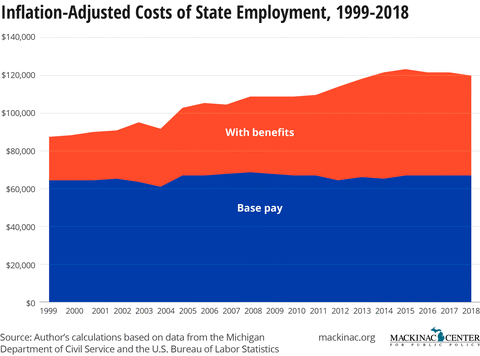Commentary
Michigan May Have Turned a Corner on the Costs of State Employment
Benefits costs remain expensive but are declining
For a long time, the costs to employ people to work for the state of Michigan increased even when the number of state employees was down. But it seems lawmakers and administrators may have finally changed the trends, and this can allow for more public servants at lower costs to taxpayers.
The number of full-time equivalent employees in Michigan’s government declined from 62,057 in 2001 to 46,588 in 2015, a 25% decrease. However, the amount that taxpayers spent on state employment increased above inflation even with the decline, largely driven by a 63% increase in employee benefits costs.
State employment started growing again around 2015, with employment inching upwards by 1% since then. But the total cost to employ the state workforce actually declined 2% over the period, as the costs of benefits declined by 5%.
Inflation-adjusted average salaries haven’t changed dramatically: staying between $60,500 and $68,500 over the past 20 years. (All dollar figures are adjusted for inflation.) Yet the costs of their employment benefits grew significantly from 2001 to 2015, increasing from $26,000 a year on average to $56,460, in 2015. Since then the cost of benefits declined to $53,300 per worker.

The costs of the state’s two major employee benefits, retirement and insurance, have begun to decline. Retirement costs more than tripled from 2001 to 2015, but are down since. Insurance coverage cost taxpayers $10,600 per employee in 2001 and increased to $15,600 in 2011 but dropped to $13,300 in 2018.
Lawmakers are directly responsible for some of the decrease. Employees are now responsible for 20% of the costs of their health insurance.
Payments into the retirement system are still high. They cost an average of $34,000 per year. The state retirement system went from near full funding to owing employees and retirees $6 billion, which is a problem when the system isn’t supposed to have any unfunded pension debt. And this underfunding doesn’t make employment benefits any more generous, so the debt is bad for employees and taxpayers alike.
New employees haven’t been offered participation in that plan since 1997 but now receive 401(k)-style retirement benefits and no unfunded liabilities have been generated for them.
The state also has offered to pay employment insurance costs upon retirement, even for employees covered by Medicare. The state had been simply paying insurance premiums as they came due, but lawmakers have attempted to set money aside to pay for what has been offered. They are roughly a quarter of the way there according to their most recent financial statements.
The costs of employment benefits are still high. But there has been progress and the trends are headed in the right direction. It has also meant that the state can hire more people and also spend less on total employment. And that’s good for Michigan taxpayers.
|

Michigan May Have Turned a Corner on the Costs of State Employment
Benefits costs remain expensive but are declining
For a long time, the costs to employ people to work for the state of Michigan increased even when the number of state employees was down. But it seems lawmakers and administrators may have finally changed the trends, and this can allow for more public servants at lower costs to taxpayers.
The number of full-time equivalent employees in Michigan’s government declined from 62,057 in 2001 to 46,588 in 2015, a 25% decrease. However, the amount that taxpayers spent on state employment increased above inflation even with the decline, largely driven by a 63% increase in employee benefits costs.
State employment started growing again around 2015, with employment inching upwards by 1% since then. But the total cost to employ the state workforce actually declined 2% over the period, as the costs of benefits declined by 5%.
Inflation-adjusted average salaries haven’t changed dramatically: staying between $60,500 and $68,500 over the past 20 years. (All dollar figures are adjusted for inflation.) Yet the costs of their employment benefits grew significantly from 2001 to 2015, increasing from $26,000 a year on average to $56,460, in 2015. Since then the cost of benefits declined to $53,300 per worker.
The costs of the state’s two major employee benefits, retirement and insurance, have begun to decline. Retirement costs more than tripled from 2001 to 2015, but are down since. Insurance coverage cost taxpayers $10,600 per employee in 2001 and increased to $15,600 in 2011 but dropped to $13,300 in 2018.
Lawmakers are directly responsible for some of the decrease. Employees are now responsible for 20% of the costs of their health insurance.
Payments into the retirement system are still high. They cost an average of $34,000 per year. The state retirement system went from near full funding to owing employees and retirees $6 billion, which is a problem when the system isn’t supposed to have any unfunded pension debt. And this underfunding doesn’t make employment benefits any more generous, so the debt is bad for employees and taxpayers alike.
New employees haven’t been offered participation in that plan since 1997 but now receive 401(k)-style retirement benefits and no unfunded liabilities have been generated for them.
The state also has offered to pay employment insurance costs upon retirement, even for employees covered by Medicare. The state had been simply paying insurance premiums as they came due, but lawmakers have attempted to set money aside to pay for what has been offered. They are roughly a quarter of the way there according to their most recent financial statements.
The costs of employment benefits are still high. But there has been progress and the trends are headed in the right direction. It has also meant that the state can hire more people and also spend less on total employment. And that’s good for Michigan taxpayers.
Michigan Capitol Confidential is the news source produced by the Mackinac Center for Public Policy. Michigan Capitol Confidential reports with a free-market news perspective.
More From CapCon